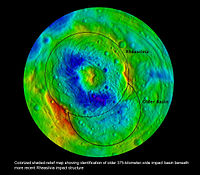Veneneia (crater)
Veneneia /vɛnɪˈniːə/ is the second-largest impact crater on asteroid 4 Vesta, at 52°S latitude. 395 kilometres (245 mi)[1] in diameter, it is 70% of the equatorial diameter of the asteroid, and one of the largest craters in the Solar System. It is at least 2 billion years old, and possibly as old as 4.2 billion years.[2] However, it is overlain and partially obliterated by the even larger Rheasilvia. It was discovered by the Dawn spacecraft in 2011. It is named after Venēneia, one of the founding vestal virgins.[3]
Vesta has a series of troughs in the northern hemisphere concentric to Veneneia. These are believed to be large-scale fractures resulting from the impact. The largest is Saturnalia Fossae, approx. 39 km wide and > 400 km long.[4]
References
[edit]- ^ 'Vesta seems more planet than asteroid', Science News, 2012 Mar 22
- ^ Jenniskens, Peter; Gabadirwe, Mohutsiwa; Yin, Qing-Zhu; Proyer, Alexander; Moses, Oliver; Kohout, Tomas; Franchi, Fulvio; Gibson, Roger L.; Kowalski, Richard; Christensen, Eric J.; Gibbs, Alex R. (2021). "The impact and recovery of asteroid 2018 LA". Meteoritics & Planetary Science. 56 (4): 844–893. arXiv:2105.05997. Bibcode:2021M&PS...56..844J. doi:10.1111/maps.13653. ISSN 1945-5100.
- ^ Veneneia, Gazetteer of Planetary Nomenclature, 2012 Feb 28 (NASA coordinates)
- ^ "EXPLORATION OF SATURNALIA FOSSA AND ASSOCIATED STRUCTURES IN VESTA'S NORTHERN HEMISPHERE". Archived from the original on 3 February 2014. Retrieved 15 September 2012.



